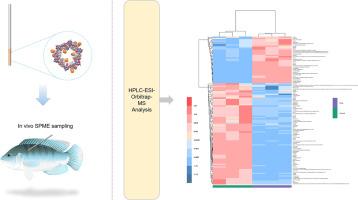Investigating the impact of novel brominated flame retardants (NBFRs) on metabolite and nutritional profiles in aquatic organisms by in vivo solid-phase microextraction (SPME)
IF 6.5
Q1 CHEMISTRY, ANALYTICAL
引用次数: 0
Abstract
Novel brominated flame retardants (NBFRs), due to their ubiquitous environmental distribution in aquatic ecosystems and potential adverse effects to aquatic biota, have initiated global concerns. NBFRs were absorbed and bioaccumulated into aquatic organisms, impairing their growth while significantly disrupting metabolic and nutritional profiles deserves further elucidation, especially for in vivo and in situ characterization. In this study, we selected tilapia (Oreochromis mossambicus) as a model and developed an innovative in vivo sampling method using solid-phase microextraction (SPME) with a cationic covalent organic framework (COF) coating fiber, coupled with high performance liquid chromatography-electrospray ionization-Orbitrap mass spectrometry (HPLC-ESI-Orbitrap-MS) analysis. Our results demonstrated that self-made SPME fibers possessed excellent broad-spectrum extraction ability (totally 5250 molecular features were detected), and the developed analysis method has the advantages of greenness. SPME technology based on our self-made fiber was successfully applied in research of the impacts of NBFRs on tilapia. After statistical analysis, a total of 811 metabolites exhibited significant differential expression, including the nutritional components such as amino acids, glycosides, and lipids, which resulted in a decline in nutritional quality. These findings provided a new perspective for evaluating the ecological risk assessment of NBFRs, nutritional quality assessment of aquatic organisms and securing fishery products.

利用体内固相微萃取(SPME)技术研究新型溴化阻燃剂对水生生物代谢物和营养成分的影响
新型溴化阻燃剂(NBFRs)由于其在水生生态系统中普遍存在的环境分布和对水生生物群的潜在不利影响,引起了全球的关注。nfrs被吸收并积累到水生生物中,损害了它们的生长,同时显著破坏了它们的代谢和营养特征,值得进一步阐明,特别是在体内和原位表征方面。本研究以罗非鱼(Oreochromis mossambicus)为研究对象,采用阳离子共价有机骨架(COF)涂层纤维固相微萃取(SPME),结合高效液相色谱-电喷雾电离-轨道阱质谱(HPLC-ESI-Orbitrap-MS)分析,建立了一种创新的体内取样方法。结果表明,自制SPME纤维具有优异的广谱提取能力(共检测到5250个分子特征),所建立的分析方法具有绿色环保的优点。基于自制纤维的SPME技术成功应用于nfrs对罗非鱼的影响研究。经统计分析,共有811种代谢物表现出显著的差异表达,包括氨基酸、糖苷、脂类等营养成分,导致营养品质下降。这些发现为nfrs生态风险评价、水生生物营养质量评价和水产品安全提供了新的视角。
本文章由计算机程序翻译,如有差异,请以英文原文为准。
求助全文
约1分钟内获得全文
求助全文

 求助内容:
求助内容: 应助结果提醒方式:
应助结果提醒方式:


